Many countries require food products containing major allergens to declare so on the product’s packaging. However, regulations dictating which allergens must be disclosed, and how, vary by country or region. For example, in the U.S. and Canada, the specific breed of fish or shellfish must be declared when present.
This blog will cover how to build, view, and edit your allergen statements. We will also cover how to add new allergens to the database.
Allergens in Genesis R&D Food
Genesis R&D comes pre-populated with the major allergen food groups for the U.S., Canada, Mexico, and European Union. Genesis R&D allows you to add your own allergens to the database so that you can be fully compliant with the specific declaration requirements for each country. Check out our cheat sheet, Allergen Labeling by Country, to learn more about what additional allergens you may need to add to the database.
Because the program errs on the side of caution, all Ingredients in the ESHA database, as well as all user-added Ingredients, will initially have all the default database allergens selected.
Below is a list of all default program allergens for all label modules available in Genesis R&D:
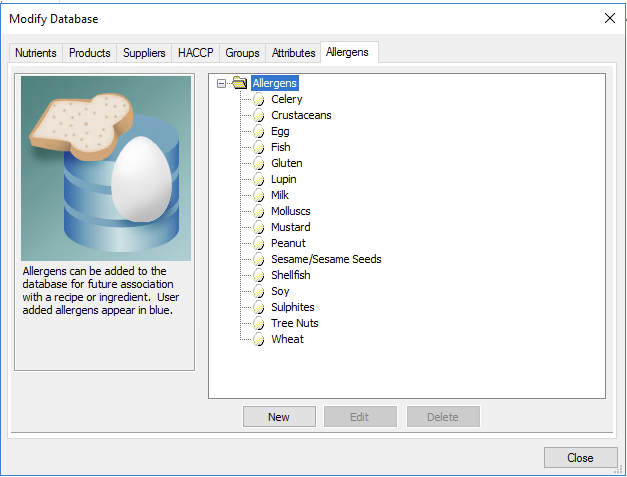
Note: if this list looks different than yours, check your program preferences. To do so, navigate to My Preferences > Label > Allergens. Then check which country allergens you wish to see, or un-check to hide.
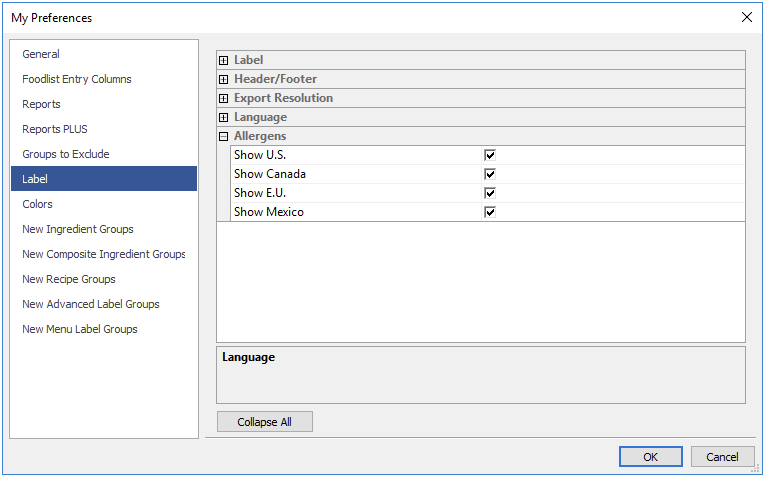
Adding Allergens to the Database
- Navigate to the Database tab from the ribbon and click Modify.
- Select the Allergens tab and click new.
- Enter the name of the allergen you wish to add
- Select the appropriate Type, either Folder or Allergen.
- Select the appropriate Default Location, either the Allergen Statement (Contains) or Additional Allergen Statement (May Contain).
- Enter translations for other languages, if necessary.
- Click OK.
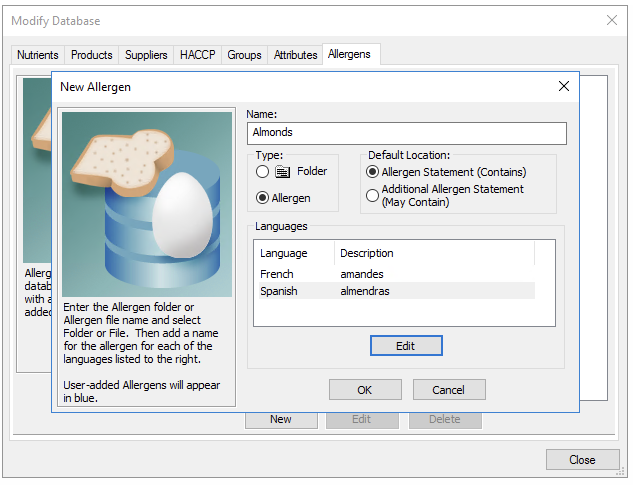
You will see that user-added allergens appear in blue. Genesis R&D will automatically add (May Contain) next to allergens that have been designated as “May Contain.” However, (May Contain) will not appear in the contains statement.

Modifying Allergens at the Ingredient Level
- Open or create a new Ingredient.
- Select Allergens.
- Check any allergens present in your ingredient and uncheck the rest. You can uncheck them all by selecting “Clear All Allergens.”
- Now when you use this Ingredient in a Recipe, only the allergens selected will appear in the Recipe allergen statement.
Note: When you open an ESHA item or create an ingredient for the first time, your list of allergens will look something like this, with all of the default allergens checked, and user-added allergens un-checked:
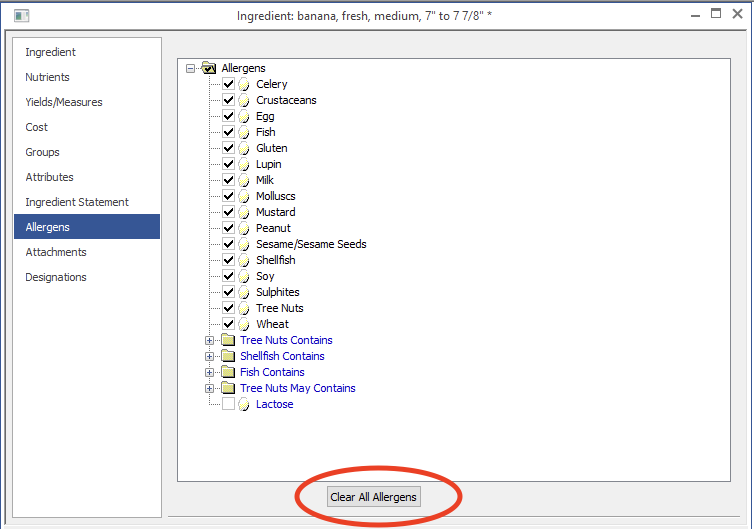
Viewing Allergens at the Recipe Level
While you CAN modify allergens at the Recipe level, this practice is NOT recommended. As a best practice, Allergens should be managed at the Ingredient level. Changes made to Ingredients at the Recipe level will SAVE and effect all Recipes that use that Ingredient.
- Open or create a new Recipe.
- Click Allergen Statement on the Recipe ribbon to open the Allergen Statement window.
- The top pane shows the allergens associated with this Recipe as a whole.
- The middle pane shows which allergens are associated with which Ingredients.
- The bottom pane shows how this allergen statement will appear on the label.
- At this point, you can either uncheck the allergen in the top or middle panes. If you know that you can safely remove the egg allergen from all Ingredients, uncheck Egg in the top (Recipe) pane. When you uncheck an allergen in the Recipe pane, you will get a message warning you that this action will clear the allergen from the Recipe and all Ingredients used in the Recipe.
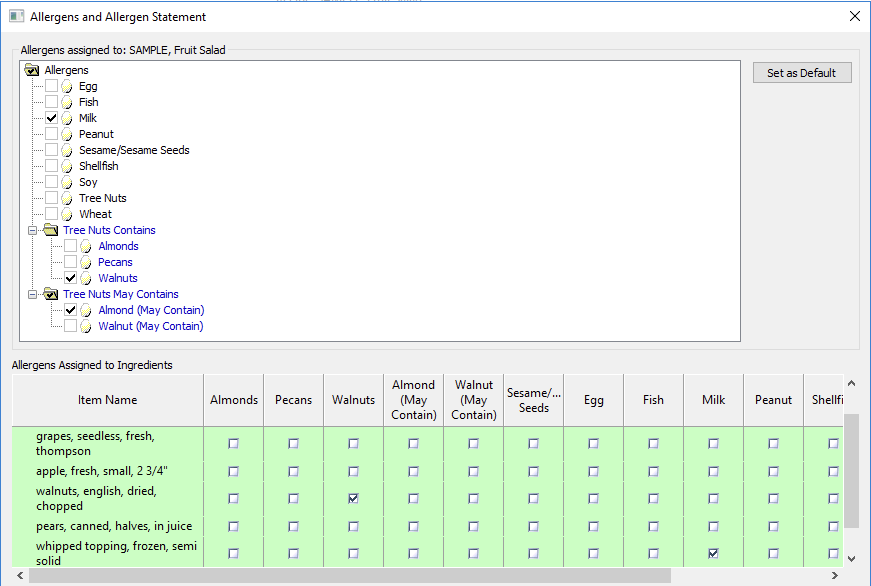
Allergen Statement View
Selected allergens will appear in the Allergen Statement.

If you checked Almonds (May Contain) or any user-added ingredients, the program will automatically generate an Additional Allergen (“May contain”) statement:

Advisory statements are not required. If using an advisory statement, “May Contain” is not required wording. You could also use something like “This product was processed on machinery used to process…” or “May contain traces of…” or whatever makes sense for your product. You can change the wording by clicking Edit and manually typing in new text.
Displaying Allergens on Your View Label Report
- When you have finished editing your Allergen Statement, Click OK.
- Click Label display and you will see your allergen statement appear next to your label.
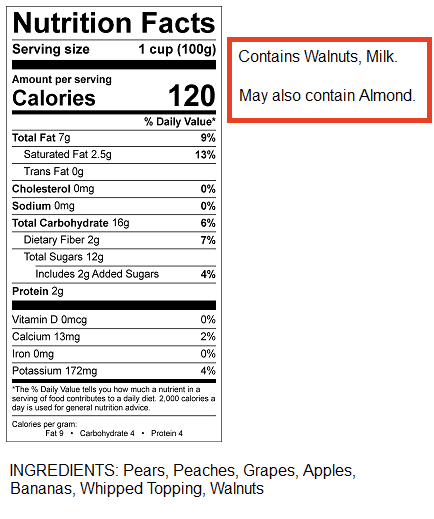
Tutorial: Declaring Allergens in Genesis R&D Foods
Tutorial: Adding User-Added Allergens to the Database
Other posts you might be interested in
View All Posts
Food Labeling
2 min read
| April 23, 2021
Sesame Added As the 9th Major U.S. Food Allergen
Read More
Food Labeling
18 min read
| October 8, 2021
How to Declare Sesame as an Allergen in Genesis R&D Foods
Read More
Product Formulation
12 min read
| January 27, 2023

